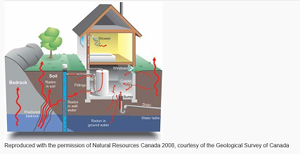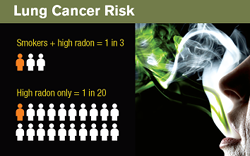Guides & Resources
All guides and resources are for informational purposes only. It is the responsibility of the Applicant/Designer to review the building code to ensure all information is complete, accurate, and up to date.
Deck Guide
Are you looking to add a deck to your property? Our deck guide provides definitions, sample drawings, construction details, and information to help you get started.
Guest Cabin Guide
This guide will assist you with building a guest cabin on your property.
Radon
If you are interested in testing your home for Radon, you can obtain one of the radon measurement devices listed on the Canadian National Radon Proficiency Program (C-NRPP) website from a local Hardware store or click on the following link for a list of Canadian National Radon Proficiency Program (C-NRPP), approved online retailers: Online Retailers.
What is Radon?
Radon is a radioactive gas that is formed naturally by the breakdown of uranium in soil and rock. It is slowly released from the ground and as the gas breaks down further, it forms radioactive particles that can be breathed into the lungs.
Why is it dangerous?
When radon is released from the ground outside it mixes with fresh air and gets diluted, resulting in concentrations too low to be of concern. However, when radon enters an enclosed space, like a house or basement, it can accumulate to high concentrations and become a health risk. People who inhale high levels of radon over a prolonged period are at an increased risk for developing lung cancer.
How can Radon affect my health?
The only known health risk associated with exposure to high levels of radon in indoor air is an increased lifetime risk of developing lung cancer. Other than lung cancer, there is no evidence that radon exposure causes other harmful health effects.
As Radon breaks down, it forms radioactive particles that can get lodged into your lung tissue as you breathe and can damage your lung cells. When lung cells are damaged, they have the potential to result in cancer. Not everyone exposed to radon will develop lung cancer, and the time between exposure and the onset of the disease can take many years.
How high is the risk of developing lung cancer?
Radon is the cause of about 3,200 deaths in Canada each year, which is more than the number of annual deaths attributed to vehicle collisions, exposure to carbon monoxide, and fire-related deaths, combined1.
The risk from radon exposure is long term and depends on the level of radon, how long a person is exposed and their smoking habits.
Radon is the 2nd leading cause of lung cancer, after smoking. It is the number one cause of lung cancer in non-smokers. Non-smokers have a 1 in 20 risk of getting lung cancer if radon levels in your house are high.
Does the risk of developing lung cancer for smokers increase if they are also exposed to elevated radon levels?
People who smoke and are exposed to elevated radon levels have a significantly higher risk of developing lung cancer.
A smoker who has never been exposed to high levels of radon for a prolonged period of time has a one in 20 risk of developing lung cancer. However, if you are a smoker AND are exposed to elevated levels of radon, your risk of developing lung cancer increases to is 1 in 3.
The Canadian Cancer Society, Take Action on Radon, and the Smokers’ Helpline have developed a factsheet on Radon and Smoking.
Are children more at risk from radon than adults?
Children have been reported to be at greater risk than adults for certain types of radiation exposure, but there is currently no conclusive data on whether children are at greater risk than adults from radon.
Is Radon in Huron County?
A radon potential map, created in 2012 and updated in 2017, shows potential areas of high risk. It shows that parts of Huron County have the potential to be high risk. This is why everyone should test their homes.
Is Radon located everywhere?
It is located everywhere across the country. It is found in high concentrations in certain areas, such as Elliot Lake in Ontario, where uranium exists in natural rock deposits. The concentration can change from town to town and even from home to home. In fact, a home can test high for radon even if the house right next door tested low. This is why Health Canada suggests that all homeowners test their home for radon.
If Radon is naturally in the environment why do I have to worry?
Think of it like the sun. The sun is natural. We know that increased exposure to high levels of UV radiation from the sun can cause skin cancer. We wear sunscreen to protect ourselves from the sun. Radon is also a form of radiation. So in the same way we have to protect ourselves from high levels of radon.
How can Radon get in my house?
Radon can enter a house through any opening where the house contacts the soil: such as cracks in foundation walls and in floor slabs, construction joints, gaps around service pipes and support posts, floor drains and sumps, and cavities inside walls. Because of their closeness to the ground, basement and first floors typically have the highest radon levels.

Are old homes more likely to have higher radon levels?
All homes, regardless of when they were constructed or if they are single or multi-story, slab or have a basement, can have radon.
The amount of Radon in a home will depend on many factors. First, radon concentrations will be higher in areas where there is a high uranium content of the soil. Also, radon gas can flow more easily through some soils than others, for example sand versus clay. Next, if the foundation in your house has a lot of cracks and openings like a sump pump there are more potential entry points for Radon.
How do I test for Radon?
Testing is the only way to know if your home has elevated radon levels.
You can test your home for radon yourself, using a kit that can be purchased online or from home supply stores. There are a few different types of kits, the most important thing is to use a long term test kit – one that takes 3 months to complete.
What do I do if I am renting my house or apartment? Is my landlord required to test for radon?
There is no legal requirement for a landlord to test a rental property. You will have to do it yourself unless your landlord agrees. Also there is no legal requirement for the landlord to remediate if the levels are found to be high. If you are living in a high rise or upper floor apartment your risk is low because radon enters through the ground.
How much do the radon test kits cost?
The kits can be purchased for about $40 – 60 dollars online and from home building stores. Just make sure to use the long term kit. There are cheaper short term test kits that take a few days but this will not give accurate results. A list of certified kits can be found at http://c-nrpp.ca/approved-radon-measurement-devices/
How does the test work?
The kit will come with instructions but basically it is placed in the lowest level of your home where you spend at least 4 hours a day. You leave the device there for three months and then return it to the lab. Most kits come with a return envelop addressed to the lab. The results will be mailed to you in a few weeks.
What do I do if I test high for Radon in my house?
The level of radon is measured in Becquerels. Health Canada recommends that any home with higher than 200 Bq/m3 take measures to remediate or fix their home.
Sometimes the fix is as simple as sealing cracks in the walls or covering open sump holes. If the levels are very high a certified radon mitigation contractor would have to be hired to install an Active Soil Depressurization System. This is a more complex fix but it basically acts like a large filter where a hole is drilled in your basement floor and a pipe is installed with a fan that draws the radon gas from under your house and pushes it outside. Once it is outside it will dissipate in the air to safe levels.
How do I find a contractor that is certified in radon mitigation?
To help provide you with the most effective radon reduction solution you should consult with a radon mitigation professional. There is a link on the Take Action on Radon website with a list of contractors in our area. You can also find a list of certified radon mitigation professionals on the Canadian - National Radon Proficiency Program website.
How much does it cost to fix my home?
The cost depends on the size and design of a home and the radon reduction methods that are needed. It can be as low as a few hundred dollars to up several thousands of dollars.
Do I have to retest after the problems are fixed?
Yes, you should definitely test to make sure that the radon levels have been reduced to below 200 bq. In fact, it is a good idea to test your home every few years since we know that the levels can change naturally.
If I am building a new house, are there any building codes for radon protection?
The National Building Code includes requirements for a radon rough-in for a future exhaust system should it become necessary. But currently Ontario has not adopted this measure into our building code. Some local municipalities have started to add radon mitigation into the local building codes. The hope is that Ontario will adopt the national codes in the near future which means that municipalities will also have to adopt it into their codes.
Will High Levels of Radon Affect the Value of my House?
If high radon levels are detected, it can most often be successfully lowered at a cost which is usually small when compared to the value of the house. Like regular maintenance, fixing the problem may in fact protect the value of your home and more importantly it will protect the health of you and your family.
Where can I learn more?
More information on radon can be found:
Canadian Cancer Society https://cancer.ca/en/cancer-information/reduce-your-risk/know-your-environment/radon
Health Canada https://www.canada.ca/en/health-canada/services/radon.html
Take Action on Radon https://takeactiononradon.ca/
Reduce Your Exposure to Radon VIDEO https://www.youtube.com/watch?v=mFIQwsfsMd0

